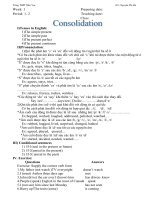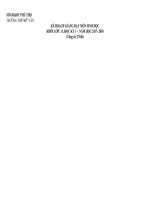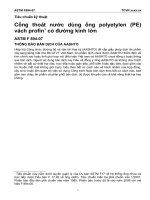Astm f 862 11 (2017)
Bạn đang xem bản rút gọn của tài liệu. Xem và tải ngay bản đầy đủ của tài liệu tại đây (59.4 KB, 2 trang )
This international standard was developed in accordance with internationally recognized principles on standardization established in the Decision on Principles for the
Development of International Standards, Guides and Recommendations issued by the World Trade Organization Technical Barriers to Trade (TBT) Committee.
Designation: F862 − 11 (Reapproved 2017)
Standard Practice for
pH and Chloride-ion Concentration of Aerospace Hydraulic
Fluids1
This standard is issued under the fixed designation F862; the number immediately following the designation indicates the year of original
adoption or, in the case of revision, the year of last revision. A number in parentheses indicates the year of last reapproval. A superscript
epsilon (´) indicates an editorial change since the last revision or reapproval.
3.1.2 The quantity of the chloride ion is determined using a
chloride selective ion electrode and a selective ion meter.
1. Scope
1.1 This practice covers the measurement of the pH and
chloride ion of water extraction of aerospace hydraulic fluids.
4. Significance and Use
1.2 The values stated in SI units are to be regarded as
standard. No other units of measurement are included in this
standard.
1.3 This standard does not purport to address all of the
safety concerns, if any, associated with its use. It is the
responsibility of the user of this standard to establish appropriate safety and health practices and determine the applicability of regulatory limitations prior to use.
1.4 This international standard was developed in accordance with internationally recognized principles on standardization established in the Decision on Principles for the
Development of International Standards, Guides and Recommendations issued by the World Trade Organization Technical
Barriers to Trade (TBT) Committee.
4.1 On application of the hydraulic fluid within the mechanical fluidic system, the fluid may become contaminated
with acid and chloride ion. Mechanical shearing of the hydraulic fluid in the presence of the minute quantity of water and
residual amount of organic solvents, used in cleaning, may
initiate formation of acid and chloride ion. Measurements are
desired to control and maintain the cleanliness and noncorrosiveness of the fluidic system.
5. Apparatus
5.1 Combination pH Selective Ion Meter,
5.2 Glass Electrode—The pH response shall be 60.05 pH.
5.3 Reference Electrode—A calomel, silver/silver chloride,
or other reference electrode of constant potential.
2. Referenced Documents
5.4 Chloride Selective Ion Electrode.
2.1 ASTM Standards:2
D512 Test Methods for Chloride Ion In Water
D1193 Specification for Reagent Water
E70 Test Method for pH of Aqueous Solutions With the
Glass Electrode
5.5 Double Junction Reference Electrode, sleeve-type
5.6 Separatory Funnel, 250 mL.
6. Reagents
6.1 Water, reagent grade, Type IV, in accordance with
Specification D1193.
3. Summary of Method
6.2 Reference Buffer Solutions, SRM/RM 185, 186,
and 187—Materials supplied by the National Institute of Standards and Technology with pH values.
3.1 The aerospace hydraulic fluid sample is shaken with
water, and the pH and the quantity of chloride ion are
determined from the water layer.
3.1.1 The pH is measured using a glass electrode and pH
meter.
7. Standardization of pH Meter
7.1 Standardize the pH meter in accordance with Test
Method E70.
1
This practice is under the jurisdiction of ASTM Committee F07 on Aerospace
and Aircraft and is the direct responsibility of Subcommittee F07.07 on Qualification Testing of Aircraft Cleaning Materials.
Current edition approved June 1, 2017. Published July 2017. Originally approved
in 1984. Last previous edition approved in 2011 as F862 –11. DOI: 10.1520/F086211R17.
2
For referenced ASTM standards, visit the ASTM website, www.astm.org, or
contact ASTM Customer Service at For Annual Book of ASTM
Standards volume information, refer to the standard’s Document Summary page on
the ASTM website.
PART A—pH MEASUREMENT
8. Procedure
8.1 Add a 50-mL sample of hydraulic fluid and 50 mL of
reagent water to a 250-mL separatory funnel.
8.2 Mix thoroughly. Allow for the water and oil layers to
separate completely.
Copyright © ASTM International, 100 Barr Harbor Drive, PO Box C700, West Conshohocken, PA 19428-2959. United States
1
F862 − 11 (2017)
8.3 Drain the water layer from the funnel into a 100-mL
beaker.
12.2 Mix thoroughly. Allow for the water and oil layers to
separate completely.
8.4 Standardize the pH-meter assembly with two reference
buffer solutions as described in section 7.1. Wash the electrodes
with three changes of water. Equip the beaker with a small
laboratory-type mechanical stirrer having a glass agitator or
with a magnetic stirring unit having an inert, plastic-covered
impeller. Insert the electrodes and determine the pH value;
measure the water sample until two readings 30 s apart do not
differ by more than 0.05-pH unit. Record the pH values.
12.3 Drain the water layer from the funnel into a 250-mL
beaker.
12.4 Prepare a calibration curve and determine the chloride
ion concentration on the water layer in accordance with D512
Test Method C.
13. Calculation
9. Calculation
13.1 Read the chloride ion concentration directly from the
calibration curve prepared in section 12.4.
9.1 The pH of the sample is the average of the last two
readings.
14. Report
10. Report
14.1 Report the chloride-ion concentration to the nearest
whole integer.
10.1 Report the pH of the water extraction of hydraulic fluid
to the nearest 0.1 unit.
15. Precision and Bias
11. Precision and Bias
11.1 See Test Method E70 for Precision and Bias information.
15.1 See D512 for Precision and Bias information.
16. Keywords
PART B—CHLORIDE-ION CONCENTRATION
MEASUREMENT
16.1 chloride ion; hydraulic fluid; pH
12. Procedure
12.1 Add a 100-mL sample of hydraulic fluid and 100 mL of
reagent water to a 250-mL separatory funnel.
ASTM International takes no position respecting the validity of any patent rights asserted in connection with any item mentioned
in this standard. Users of this standard are expressly advised that determination of the validity of any such patent rights, and the risk
of infringement of such rights, are entirely their own responsibility.
This standard is subject to revision at any time by the responsible technical committee and must be reviewed every five years and
if not revised, either reapproved or withdrawn. Your comments are invited either for revision of this standard or for additional standards
and should be addressed to ASTM International Headquarters. Your comments will receive careful consideration at a meeting of the
responsible technical committee, which you may attend. If you feel that your comments have not received a fair hearing you should
make your views known to the ASTM Committee on Standards, at the address shown below.
This standard is copyrighted by ASTM International, 100 Barr Harbor Drive, PO Box C700, West Conshohocken, PA 19428-2959,
United States. Individual reprints (single or multiple copies) of this standard may be obtained by contacting ASTM at the above
address or at 610-832-9585 (phone), 610-832-9555 (fax), or (e-mail); or through the ASTM website
(www.astm.org). Permission rights to photocopy the standard may also be secured from the Copyright Clearance Center, 222
Rosewood Drive, Danvers, MA 01923, Tel: (978) 646-2600; />
2









